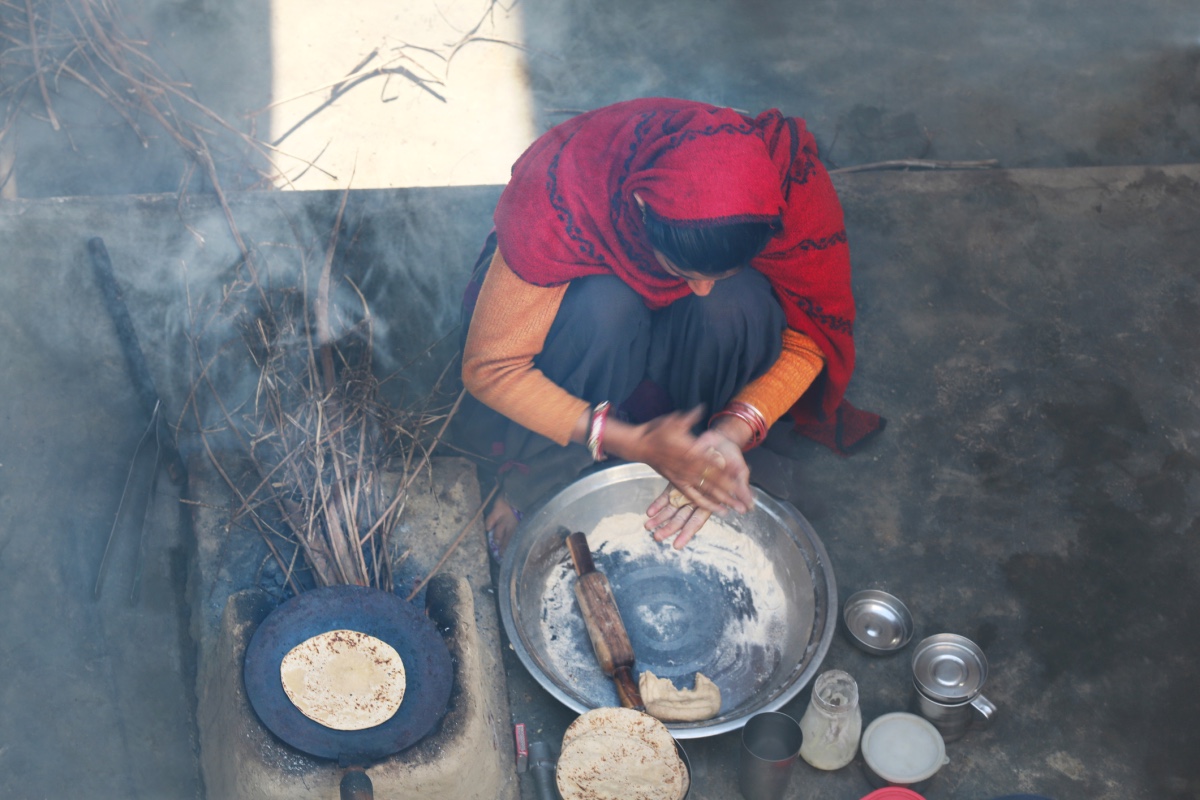‘The kitchen kills more than the swords’ – Latin Proverb
The World’s attention has been focused on one health issue over the past years: Covid-19. But inadequate attention is paid to a persistent and insidious problem. We often gloss over the extent to which toxic fumes emanate from open-fire traditional cookstoves (Chulhas) fueled by solid fuels (including coal and biomass fuels, such as firewood, charcoal, dung, agricultural residue and sometimes leaves and grass) is jeopardising the health of our rural women and children.
Advertisement
The smoke released by these Chulahs seems to be equivalent to 400 cigarettes every hour and causes indoor air pollution. But, surprisingly, the vital issue fails to attract the appropriate attention of policymakers and scientists at national as well as international levels.
Such an attitude may be due to the low status of women (and children) in developing countries, especially of poor women who are the worst sufferers as they are the people with little political or economic clout.
In rural and suburban areas, cooking is commonly done in poorly ventilated rooms. Besides, most households do not have a separate kitchen, and cooking stoves are used for several hours each day and generate a significant amount of indoor air pollution.
The 2010 Global Burden of Diseases Report (DBDR) report established that indoor air pollution from cooking stoves is a primary cause of disease and death in South Asia. As many as 1.04 million premature deaths and 31.4 million disability-adjusted life years (DALYS) ~ a measure of years lost due to ill-health, disability or early death ~ are caused by exposure to biomass burning in poorly ventilated homes. According to this report, indoor air pollution is the second largest killer in India after blood pressure, claiming two lives every minute.
Writing in Nature Substantiality, N D Rao et al. illuminate the double burden of air pollution experienced by the poorest households in India: smoke from burning solid fuels and disproportionate exposure to ambient air pollution from the general household consumption, caused by affluent urban households that have higher consumption emission per capita.
The report entitled State of Global Air 2018 based on GBDR has estimated that long-term exposure to outdoor and indoor pollution air pollution, the so-called ‘double burden’, contributed to around 6.1 million premature deaths from stroke, heart attacks, lung cancer and chronic lung diseases and to a loss of 106 million life-years worldwide in 2016.
The paper in The Lancet Planetary Health also says that household air pollution is responsible for 40 per cent of air pollution deaths in India. Fine particles or PM 2.5 are primarily responsible for the disease burden. Life in a poor household revolves around the cooking area. Women spend considerable time cooking and maintaining the kitchen. Women and children are exposed to indoor air pollutants. There is substantial data available in India, and globally, on the link between solid fuel use in households and health consequences for women and children.
Children are the worst victims. Globally, exposure to indoor smoke from solid fuels is responsible for over half of the 1.8 million child deaths from acute lower respiratory infections, making it the largest environmental factor causing ill-health and death among children. Interestingly, based on the measurement and modelling results from India, the GDB has estimated daily average PM 2.5 exposure of 285 micrograms per cubic meter, 337 micrograms per cubic meter and 204 micrograms per cubic meter for children, women, and men respectively. But exposure during cooking can be several times higher than these levels.
Studies carried out by Kalpana Balakrishnan, an indoor air pollution expert from Sri Ramachandra Medical College in Chennai, along with some other scientists have shown that mean average exposure concentrations can be as high as 570 micrograms per cubic meter in households that use solid fuels. Kirk Smith, another expert on household air pollution from the University of California, Berkeley, who worked extensively on household pollution in India, also pointed out that not only rural mothers but rural infants and children are more vulnerable because of the following reasons:
1. Immaturity of their respiratory defence mechanism and geometry of their airways.
2. Children are physically more active than adults and this increases their vulnerability to air pollution.
3. They have significantly higher oxygen demands so their respiration rates are higher, and they inhale more air per unit of body weight than adults. Their smaller stature results in a lower breathing zone, so they inhale air loaded with more particles.
4. The diameters of their airways are smaller and more likely to be affected by inflammation produced by air pollution
Indian children, on average, are shorter not only than children in the poorer sub-Saharan African (SSA) countries; they are among the shortest in the world. Such large-scale stunting has been described as the ‘Asia enigma’. Research by Dean Spears sheds light on the puzzle. His analysis of as many as 140 demographic and health surveys has found that the height of Indian children correlates with their and their neighbours’ access to toilets, and that open defecation (OD) accounts for much of the excess stunting in India. There is also credible evidence that exposure to indoor air pollution from the burning of solid fuels increases the probability of stunting (low-weight-for age) among children. While stunting is most commonly associated with poor nutrition, there is an emerging body of research that links exposure to poor air quality to stunt- ing. Combustion of solid fuels ~ such as coal, woods, crop residues, dung ~ releases particulate matter, carbon monoxide, formaldehyde and other toxins. Children’s lungs still develop- ing and are therefore susceptible to irritation and contamination from fumes of solid cooking fuels.
When their bodies repeatedly fight off respiratory infections the fumes provoke, their growth suffers. Analysis of NFHS-3 data firmly established that around 6.5 per cent of stunting cases in Indian children below three are associated with the burning of solid fuels.
Growth stunting in childhood is a risk factor for increased mortality, poor cognitive and motor development, and other impairments in functions including delayed walking, impeded speech development and diminished school performance which increases the risks of drop-out or repeat grades. Moreover, stunting usually persists, leading to small- er size and poorer performance in adulthood.
Despite high economic growth during the last few decades, India still has the highest prevalence of stunting among South Asian economies, with the exception of war-stricken Afghanistan.
Nobel Laureate Prof. Amartya Sen had once described the situation as “India’s defective development”. Indeed, inadequate availability of clean fuels and persistent dependence on hazardous solid fuels by the rural poor corroborates the observation.
Several surveys have established that chronic lung diseases and the damages caused due to staying long in close proximity to heat generated by cooking stoves severely affect women between the ages of 30 and 50 years, which should be the most productive period of their lives.
The main health effects of domestic smoke pollution among women are (1) respiratory diseases and cor pulmonale; (2) adverse pregnancy outcomes (stillbirths, neonatal deaths and low birth weight); (3) cancer and (4) Eye problems.
As a rule, the pattern of household energy consumption represents the state of economic development. But the fact is, though countries like India (and parts of China and Africa) may have modernized, the bulk of cooking in rural villages is still done using firewood and twigs.
Considering the population growth read with the stages of economic growth and level of urbanisation the International Energy Agency predicted that globally as many as 2.7 billion people would be relying on traditional biomass-based fuels (fuelwood, crop residues, and animal dung) in the year 2030.
India is one of the most diverse countries with a population of 121.1 crores (Census of India 2011) or 139 crores (in 2021), the second largest in the world. Close to 68 per cent of the population live in rural areas, and their income largely depends upon agricultural activities.
Disparities in household energy consumption exist between rural and urban populations and between high and low- income groups. The energy carriers are used for multiple purposes, such as cooking, water heating, lighting etc.










